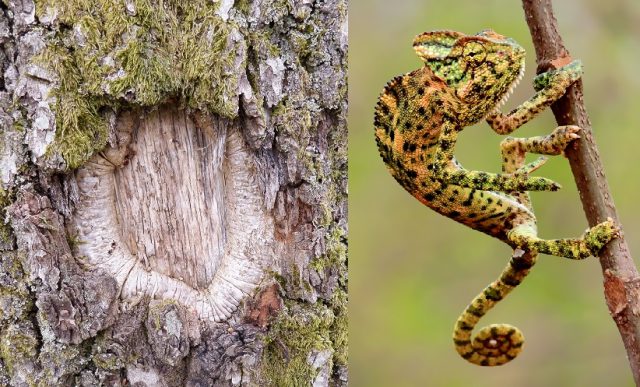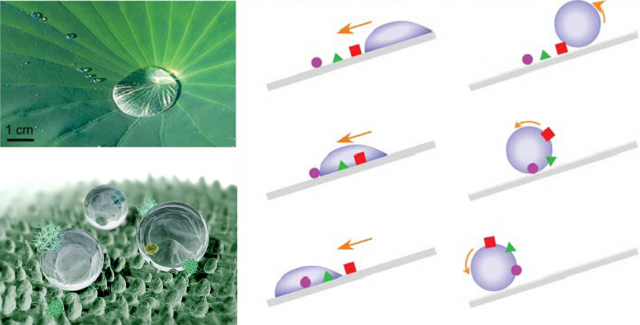Bio-inpired self-healing materials
Plants and animals are provided with startling self-healing and defence mechanisms. Think of how trees achieve wound closure after losing a limb through callus formation, or the ability of the chameleon to adapt the colour of the skin according to its surroundings through reversible muscle control. These are very well-known examples where living nature teaches us how to avoid damage before it takes place or, once the damage is done, how to restore both structure and function as fast and efficiently as possible. The final objective is always the same: the fight for survival against injury and infection.
The study of self-healing and defence mechanisms in plants and animals involves a good number of disciplines, including botany, zoology, chemistry and biology, some of them quite far from the realms of Materials Science. However, materials scientists have been looking at this field of knowledge with great interest for decades, as it sits at the border of one of the most motivating topics in Materials Science: the design of new materials with self-healing and defence properties. Repair of certain materials during their lifecycle (especially those with structural functions such as concrete) can be very expensive and labour intensive. That’s why the promise of these materials having self-healing properties, that is, no needing external intervention to repair internal damage, is an attractive goal to pursue both for scientists and manufacturers.

In order to make it easier for materials scientists to understand the prevailing self-healing and defence mechanisms in nature, the Nanoprobe Laboratory for Bio & Nanotechnology and Biomimetics (NLBB) from The Ohio State University (USA) has recently published and extensive review1 on these mechanisms, emphasising those which can serve or have already served as inspiration for the design of novel materials. The aim is to create a classificatory guide showing nature’s best evolutionary healing and defence methods, optimised over the course of millions of years, to enable those not versed in the matter to have a deeper understanding of these phenomena.
The work classifies the prevalent mechanisms according to whether they belong to fauna or flora; then, basic functioning principles in each group are identified. With these premises in mind, they find five predominant responses to external threats within the animal kingdom (reversible muscle control, clotting, cellular response, layering and protective surfaces) and three of them in flora (vascular networks or capsules, exposure and functional coatings). It goes without saying that none of them exclude each other in the event of damage.
One illustrative example where nature inspires the development of novel materials is the use of reversible muscle control. Muscle control, either voluntary or not, is at the base of life itself. By turning chemical energy into mechanical movement, our muscles can reversibly deform and allow us to perform activities such as running, breathing or digestion. Reversible muscle control is also an effective defence mechanism, as it can be observed in the adaptive camouflage of chameleons. Under an external threat, chameleons are able to undergo muscle movements that provoke changes in the distance of the guanine nanocrystal layers present in their skin. The increase in this spacing shifts the reflectivity of the skin’s pigment cells from short to long wavelengths, creating the colour change. This mechanism has already inspired a good amount of research, finding promising applications in smart clothing2, artificial prosthetics or stretchable electronics3.

But, as we mentioned earlier, if there is a material where self-healing properties would bring enormous safety and economic benefits that is concrete. Concrete structures, the most widely used in construction, are very sensitive to crack formation due to its limited tensile strength. These cracks, even if they are tiny at the beginning, can end up damaging the whole structure. Due to its composition, concrete has its own natural self-healing mechanism based on different chemical reactions triggered by the addition of water. In the event of cracking, the presence of water promotes calcium mineral precipitation in the form of calcium carbonate that fills the cracks. However, this mechanism is very limited to small cracks, lacks any control on the amount and distribution of the healing substances and is wholly dependent on the addition of water.
In order to improve concrete’s self-healing properties, material scientists have taken a bioinspired approach consisting of vascular networks and capsules filled with healing agents, embedded in the concrete. This system mirrors the secretion cells and networks found in some plants, which release healing fluids when an injury damages internal tissues. It is also a very similar mechanism to that of blood clotting. The released fluids serve both as filling material to preserve the structure and as defence against microbes or any other aggressive substances.

The study of functional surfaces in nature has also enriched the strategies to create new materials with self-defence properties. An interesting example is the self-cleaning mechanism of certain plants, known as “the lotus effect”. Due to the intricate topography of their surface, the leaves of some plants cause the adhesion of water droplets to be minimal (a phenomenon called ultrahydrophobicity). This lack of adherence results in dirt particles being immediately attached to the water droplets rather than to the leave, maintaining a clean surface as the one observed in the image below. This principle has been used in the development of a number of surface treatments, coatings and fabrics, and has been applied to products where self-cleaning surfaces are crucial4, such as the glasses in sensors for traffic control or stain-resistant textiles.

Other defence strategies used in materials might not be directly bioinspired, but for sure have their natural counterpart. A bicycle helmet, based on an external hard material to scatter impact forces and an internal soft material to absorb the impact, is a good example of how layering and protective surfaces work in the development of new safety products. This mechanism is constantly present in nature too, for instance, in the ladybug showed in the picture below, whose shell is built following the same principle than the bicycle helmet.

Whether bioinspired or not, the truth is that the field of self-healing materials is still at its infancy. Most of the current strategies rely on external stimuli to activate the healing mechanism, so we cannot strictly say that they are self-healing. Heat, UV irradiation, moisture or addition of curing agents are the most usual activators. As always, a smart look at nature and an interdisciplinary approach will be the key in the future development of this area of knowledge.
References
1 J.C. Cremaldi, B. Bhushan, Bioinspired self-healing materials: lessons from nature, Beilstein J. Nanotechnol. 2018, 9, 907–935. doi:10.3762/bjnano.9.85
2 K. R. Karpagam et al, Development of smart clothing for military applications using thermochromic colorants, Journal of The Textile Institute, Vol. 108, 7, 1122, 2017. doi.org/10.1080/00405000.2016.1220818
3 H. H. Chou et al. A chameleon-inspired stretchable electronic skin with interactive colour changing controlled by tactile sensing. Nat. Commun. 6, 8011, 2015. doi: 10.1038/ncomms9011
4 J. Genzer and Abraham Marmur, Biological and Synthetic Self-Cleaning Surfaces, MRS Bulletin, Vol. 33, 2008. doi.org/10.1557/mrs2008.159